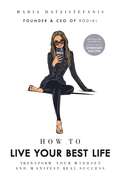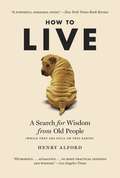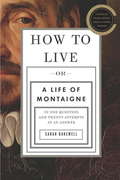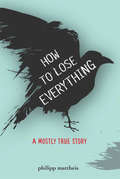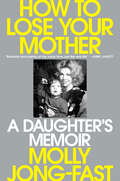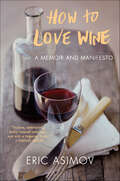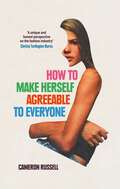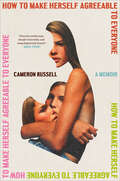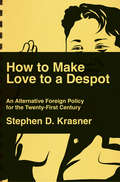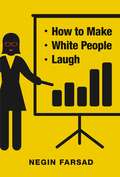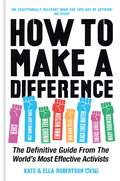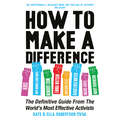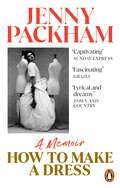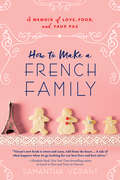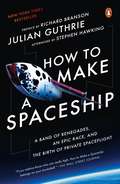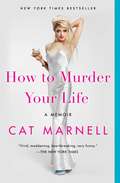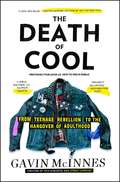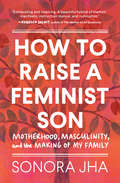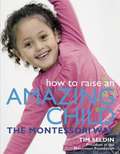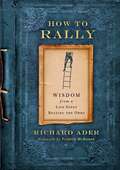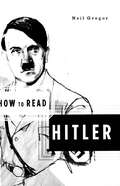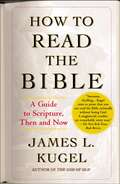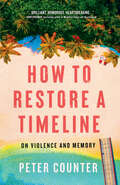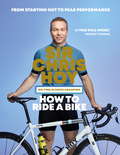- Table View
- List View
How to Live Your Best Life: Transform your mindset and manifest real success
by Maria HatzistefanisIt's time to reset, adjust and take the power back.Having spent over 20 years building her hugely successful beauty empire, Maria Hatzistefanis managed to achieve all her childhood dreams and goals. She has attended exclusive parties, walked on glamorous red carpets and visited beautiful cities. Whilst this life of glamour and success is exhilarating, Maria is shocked to find that the happiness it brings is fleeting. This leads her to realise that her life needs a new focus. In this easy to follow guide Maria asks the fundamental question 'what is happiness?'. Analysing her own experiences, failures and fortunes, Maria provides clear, concise and intuitive strategies to help you tackle your own challenges. From aligning your thoughts and actions to detaching your success from achievements, Maria shares her practical secrets to mastering your mindset. How to Live Your Best Life will equip you with the tools you need to be in control of your own destiny. Brimming with good sense, great advice and clear tips Maria guides you on your journey to happiness and ultimately success.
How to Live: A Search for Wisdom from Old People (While They Are Still on This Earth)
by Henry AlfordIn this witty guide for seekers of all ages, author Henry Alford seeks instant enlightenment through conversations with those who have lived long and lived well. Armed with recent medical evidence that supports the cliche that older people are, indeed, wiser, Alford sets off to interview people over 70--some famous (Phyllis Diller, Harold Bloom, Edward Albee), some accomplished (the world's most-quoted author, a woman who walked across the country at age 89 in support of campaign finance reform), some unusual (a pastor who thinks napping is a form of prayer, a retired aerospace engineer who eats food out of the garbage.) Early on in the process, Alford interviews his 79 year-old mother and step-father, and inadvertently changes the course of their 36 year-long union. Part family memoir, part Studs Terkel, How To Live considers some unusual sources--deathbed confessions, late-in-life journals--to deliver a highly optimistic look at our dying days. By showing that life after 70 is the fulfillment of, not the end to, life's questions and trials, How to Live delivers that most unexpected punch: it makes you actually *want* to get older.
How to Live: Or A Life of Montaigne in One Question and Twenty Attempts at an Answer
by Sarah BakewellWinner of the 2010 National Book Critics Circle Award for Biography How to get along with people, how to deal with violence, how to adjust to losing someone you love--such questions arise in most people's lives. They are all versions of a bigger question: how do you live? How do you do the good or honorable thing, while flourishing and feeling happy?This question obsessed Renaissance writers, none more than Michel Eyquem de Monatigne, perhaps the first truly modern individual. A nobleman, public official and wine-grower, he wrote free-roaming explorations of his thought and experience, unlike anything written before. He called them "essays," meaning "attempts" or "tries." Into them, he put whatever was in his head: his tastes in wine and food, his childhood memories, the way his dog's ears twitched when it was dreaming, as well as the appalling events of the religious civil wars raging around him. The Essays was an instant bestseller and, over four hundred years later, Montaigne's honesty and charm still draw people to him. Readers come in search of companionship, wisdom and entertainment--and in search of themselves.This book, a spirited and singular biography, relates the story of his life by way of the questions he posed and the answers he explored. It traces his bizarre upbringing, youthful career and sexual adventures, his travels, and his friendships with the scholar and poet Étienne de La Boétie and with his adopted "daughter," Marie de Gournay. And we also meet his readers--who for centuries have found in Montaigne an inexhaustible source of answers to the haunting question, "how to live?"
How to Lose Everything
by Philipp Mattheis Kathryn MalczykJonathan, Sam, Schulz, and Eric usually spend their summers hanging out at the park, skateboarding and dreaming about the time when they'll finally move out of the suburbs. But in the summer of 1994, the four teenagers find a small fortune hidden inside an abandoned house. What starts out as a blessing soon turns into a curse, however, as stress, drugs, and dwindling funds raise some serious questions about the future. Eighteen years later Jonathan returns to that life-changing summer to tally up the cost of that discovery, exploring how a broken dream led to a totally renewed sense of purpose.
How to Lose Your Mother: A Daughter's Memoir
by Molly Jong-FastInstant New York Times Bestseller &“With propulsive humor and perspective on her annus horribilis, Jong-Fast achieves the memoir&’s transformative work of alchemy, arming us all with lines so good you won&’t just want to underline them, you will want to cut them out to share.&” —The Washington Post &“This raw, intimate memoir is a stunning portrait of difficult relationships and how we survive them.&” —People &“Molly Jong-Fast&’s memoir is mesmerizing, intimate, wise, unputdownable, crazily honest, heartbreaking, funny, illuminating—beautiful and painful at the same time, just like real life.&” —Anne Lamott From the political writer and podcaster, a ferociously honest and disarmingly funny memoir about her elusive mother&’s encroaching dementia and a reckoning with her complicated childhoodMolly Jong-Fast is the only child of a famous woman, writer Erica Jong, whose sensational book Fear of Flying launched her into second-wave feminist stardom. She grew up yearning for a connection with her dreamy, glamorous, just out of reach mother, who always seemed to be heading somewhere that wasn&’t with Molly. When, in 2023, Erica was diagnosed with dementia just as Molly&’s husband discovered he had a rare cancer, Jong-Fast was catapulted into a transformative year.How to Lose Your Mother is a compulsively readable memoir about an intense mother–daughter relationship, a sometimes chaotic upbringing with a fame-hungry parent, and the upheavals that challenge our hard-won adulthood. A pitch-perfect balance of acceptance and rage, humor and heart, How to Lose Your Mother tells a universal story of loss alongside a singular story of a literary life. This is a memoir that will stand alongside the classics of the genre.
How to Love Wine: A Memoir and Manifesto
by Eric AsimovEric Asimov, the acclaimed chief wine critic for the New York Times, has written a beautiful and thought-provoking combination memoir and manifesto, How to Love Wine.With charm, wit, and intelligence, Asimov tells how he went from writing beer reviews for his high school newspaper on Long Island to the most coveted job in the industry. He evaluates the current wine culture, discussing trends both interesting and alarming, and celebrates the extraordinary pleasures of wine while, at the same time, questioning the conventional wisdom about wine.Whether you’re a connoisseur or a novice, already love wine or want to know it better, How to Love Wine: A Memoir and Manifesto is the book for you.
How to Make Herself Agreeable to Everyone: 'A book of real power' ? STYLIST, Best Non-Fiction Books of 2024
by Cameron RussellThe realities of the fashion industry exposed in this devastating account of the life of a successful supermodel. 'A unique and honest perspective on the fashion industry... Cameron doesn&’t just hold the door open for more voices from within fashion, she makes a compelling argument as to why they must be heard.' CHRISTY TURLINGTON BURNS Scouted by a modelling agent when she was sixteen years old, Cameron Russell approached her job with scepticism. She was a precocious and serious student with her sights set on college — not the runway. But modelling seemed to offer young women like her access to wealth, fame, and influence. Besides, as she was often reminded, there were 'a million girls in line' to replace her. A ferocious, visceral memoir, How to Make Herself Agreeable to Everyone chronicles how Russell learned to navigate the dizzying space between physical appearance and interiority, and making money in an often-exploitative system. *** 'A book of real power.' STYLIST, Best Non-Fiction Books of 2024 'Russell&’s voice is steady and compelling throughout, offering young women, especially, a thoughtful and powerful way through.' PEGGY ORENSTEIN, author of Girls & Sex 'Compelling, smart and insightful.' VENETIA LA MANNA, host of All The Small Things 'Unforgettable... Fiercely intellectual, deeply vulnerable, and unapologetically honest, Russell reads through the layers of gender, race, capital, and exploitation in the fashion industry.' IMANI PERRY, author of South to America
How to Make Herself Agreeable to Everyone: A Memoir
by Cameron RussellA bold and innovative memoir that explores who holds the power in an image-obsessed culture, from the model and activist who helped organize the movement to bring equity to fashion. &“Fiercely intellectual, deeply vulnerable, and unapologetically honest.&”—Imani Perry, National Book Award–winning author of South to America &“By elevating me for something I have no control over, the industry and economy signal to all women: there is almost nothing you can do or create that is as valuable as how you look.&” Scouted by a modeling agent when she was just sixteen years old, Cameron Russell first approached her job with some reservations: She was a serious student with her sights set on college, not the runway. But modeling was a job that seemed to offer young women like herself unprecedented access to wealth, fame, and influence. Besides, as she was often reminded, &“there are a million girls in line&” who would eagerly replace her. In her fierce and innovative memoir, Russell chronicles how she learned to navigate the dizzying space between physical appearance and interiority and making money in an often-exploitative system. Being &“agreeable,&” she found, led to more success: more bookings and more opportunities to work with the world&’s top photographers and biggest brands. But as her prominence grew, Russell found that achievement under these conditions was deeply isolating and ultimately unsatisfying. Instead of freedom, she was often required to perform the role of compliant femme fatale, so she began organizing with her peers, helping to coordinate movements for labor rights, climate and racial justice, and bringing MeToo to the fashion industry. Intimate and illuminating, How to Make Herself Agreeable to Everyone is a nuanced, deeply felt memoir about beauty, complicity, and the fight for a better world.
How to Make Love to a Despot: And Other Ways To Change American Foreign Policy In The Twenty-first Century
by Stephen D. KrasnerAfter generations of foreign policy failures, the United States can finally try to make the world safer—not by relying on utopian goals but by working pragmatically with nondemocracies. Since the end of the Second World War, the United States has sunk hundreds of billions of dollars into foreign economies in the hope that its investments would help remake the world in its own image—or, at the very least, make the world “safe for democracy.” So far, the returns have been disappointing, to say the least. Pushing for fair and free elections in undemocratic countries has added to the casualty count, rather than taken away from it, and trying to eliminate corruption entirely has precluded the elimination of some of the worst forms of corruption. In the Middle East, for example, post-9/11 interventionist campaigns in Afghanistan and Iraq have proved to be long, costly, and, worst of all, ineffective. Witnessing the failure of the utopian vision of a world full of market-oriented democracies, many observers, both on the right and the left, have begun to embrace a dystopian vision in which the United States can do nothing and save no one. Accordingly, calls to halt all assistance in undemocratic countries have grown louder. But, as Stephen D. Krasner explains, this cannot be an option: weak and poorly governed states pose a threat to our stability. In the era of nuclear weapons and biological warfare, ignoring troubled countries puts millions of American lives at risk. “The greatest challenge for the United States now,” Krasner writes, “is to identify a set of policies that lie between the utopian vision that all countries can be like the United States . . . and the dystopian view that nothing can be done.” He prescribes a pragmatic new course of policy. Drawing on decades of research, he makes the case for “good enough governance”—governance that aims for better security, better health, limited economic growth, and some protection of human rights. To this end, Krasner proposes working with despots to promote growth. In a world where a single terrorist can kill thousands or even hundreds of thousands of people, the United States does not have the luxury of idealistically ignoring the rest of the world. But it cannot remake the world in its own image either. Instead, it must learn how to make love to despots.
How to Make White People Laugh
by Negin FarsadFrom the acclaimed writer, director, and star of the hit documentary The Muslims are Coming! comes a memoir in essays about growing up Iranian-American in a post-9/11 world and the power of comedy to combat racism. Negin Farsad is an Iranian-American-Muslim female stand-up comedian who believes she can change the world through jokes. And yes, sometimes that includes fart jokes. In this candid and uproarious book, Farsad shares her personal experiences growing up as the "other" in an American culture that has no time for nuance. In fact, she longed to be black and/or Mexican at various points of her youth, you know, like normal kids. Right? RIGHT? Writing bluntly and hilariously about the elements of race we are often too politically correct to discuss, Farsad takes a long hard look at the iconography that still shapes our concepts of "black," "white," and "Muslim" today-and what it means when white culture defines the culture. Farsad asks the important questions like, What does it mean to have a hyphenated identity? How can we actually combat racism, stereotyping, and exclusion? Do Iranians get bunions at a higher rate than other ethnic groups? (She's asking for a friend.) HOW TO MAKE WHITE PEOPLE LAUGH tackles these questions with wit, humor, and incisive intellect. And along the way, you might just learn a thing or two about tetherball, Duck Dynasty, and wine slushies.
How to Make a Difference: The Definitive Guide from the World's Most Effective Activists
by Kate Robertson Ella Robertson"An exceptionally relevant book for this age of activism." Bob GeldofWith a foreword by Kofi Annan, former Secretary-General of the UN (1997-2006).How to Make a Difference is a practical roadmap to modern day activism created by the powerful and imaginative minds behind the world's biggest campaigns including Colin Kaepernick, Emma Watson, Sir Bob Geldof, Fatima Bhutto, Black Lives Matter, Doutzen Kroes, Yeonmi Park, Terry Crews, Cher, Matt Damon, Paul Polman and Gina Miller; collectively they combine the latest models of thinking, their real life experiences, radical techniques and effective advice in order to help incentivize everyone and anyone who has ever wondered, how can I help? From How to Change the Law, How to Protest, How to Use Social Media Effectively, How to End a Problem Forever and How to Change a Big Organization, this book educates as much as it encourages and informs us all to see the world as something that can and must be changed. This book will help you find an active role in positive, necessary activism and meaningful change on every scale across the globe. The only book to pool together the biggest names in activism and showcase how they have used their voices, their networks and their abilities to change the world around us.How to Make a Difference speaks to a generation who are switching selfie-sticks for protest placards and will showcase how everyone has the ability to be the change they want to see in the world.If not now, when? If not you, who?Perfect for fans of This Is Not a Drill, No One Is Too Small to Make a Difference and There Is No Planet B.
How to Make a Difference: The Definitive Guide from the World's Most Effective Activists
by Kate Robertson Ella Robertson"An exceptionally relevant book for this age of activism." Bob GeldofWith a foreword by Kofi Annan, former Secretary-General of the UN (1997-2006).How to Make a Difference is a practical roadmap to modern day activism created by the powerful and imaginative minds behind the world's biggest campaigns including Colin Kaepernick, Emma Watson, Sir Bob Geldof, Fatima Bhutto, Black Lives Matter, Doutzen Kroes, Yeonmi Park, Terry Crews, Cher, Matt Damon, Paul Polman and Gina Miller; collectively they combine the latest models of thinking, their real life experiences, radical techniques and effective advice in order to help incentivize everyone and anyone who has ever wondered, how can I help? From How to Change the Law, How to Protest, How to Use Social Media Effectively, How to End a Problem Forever and How to Change a Big Organization, this book educates as much as it encourages and informs us all to see the world as something that can and must be changed. This book will help you find an active role in positive, necessary activism and meaningful change on every scale across the globe. The only book to pool together the biggest names in activism and showcase how they have used their voices, their networks and their abilities to change the world around us.How to Make a Difference speaks to a generation who are switching selfie-sticks for protest placards and will showcase how everyone has the ability to be the change they want to see in the world.If not now, when? If not you, who?Perfect for fans of This Is Not a Drill, No One Is Too Small to Make a Difference and There Is No Planet B.(p) 2019 Octopus Publishing Group
How to Make a Dress: Adventures in the art of style
by Jenny Packham‘From inspiration to sketch, pattern to fabric, the making of a dress has been the structure that has held me, and my passion to dress others is the momentum of my life.’ Jenny Packham is one of Britain’s leading designers and most in-demand couturiers, known for her exquisite dresses made for brides, celebrities and even royalty. In How to Make a Dress, she explores her creative journey in a brilliant meditation on life and style.Beginning with the search for creative inspiration and taking us into her studio then onto the red carpet and beyond, she asks the questions that have preoccupied us for centuries: What makes the perfect dress? What do our clothes mean to us? And why do we dress the way we do? Whether she is on the trail of Marilyn Monroe in LA, designing a bespoke piece for the red carpet or sketching for a new collection, Jenny documents her pursuit of the eternal truths of style. Decades in the making, How to Make a Dress is an unforgettable book for anyone who has ever loved a piece of clothing.
How to Make a French Family: A Memoir of Love, Food, and Faux Pas
by Samantha VérantSay bonjour to a whole new way of life!Take one French widower, his two young children, and drop a former city girl from Chicago into a small town in southwestern France. Shake vigorously... and voilá: a blended Franco-American family whose lives will all drastically change.Floating on a cloud of newlywed bliss, Samantha couldn't wait to move to France to begin her life with her new husband, Jean-Luc, and his kids. But almost from the moment the plane touches down, Samantha realizes that there are a lot of things about her new home—including flea-ridden cats, grumpy teenagers, and language barriers—that she hadn't counted on.Struggling to feel at home and wondering when exactly her French fairy tale is going to start, Samantha isn't sure if she really has what it takes to make it in la belle France. But when a second chance at life and love is on the line, giving up isn't an option. How to Make a French Family is the heartwarming and sometimes hilarious story of the culture clashes and faux pas that , in the end, add up to one happy family.
How to Make a Spaceship: A Band of Renegades, an Epic Race, and the Birth of Private Spaceflight
by Stephen Hawking Richard Branson Julian GuthrieThe historic race that reawakened the promise of manned spaceflight. <p> Alone in a Spartan black cockpit, test pilot Mike Melvill rocketed toward space. He had eighty seconds to exceed the speed of sound and begin the climb to a target no civilian pilot had ever reached. He might not make it back alive. If he did, he would make history as the world’s first commercial astronaut. The spectacle defied reason, the result of a competition dreamed up by entrepreneur Peter Diamandis, whose vision for a new race to space required small teams to do what only the world’s largest governments had done before. <p><p>Peter Diamandis was the son of hardworking immigrants who wanted their science prodigy to make the family proud and become a doctor. But from the age of eight, when he watched Apollo 11 land on the Moon, his singular goal was to get to space. When he realized NASA was winding down manned space flight, Diamandis set out on one of the great entrepreneurial adventure stories of our time. If the government wouldn’t send him to space, he would create a private space flight industry himself. In the 1990s, this idea was the stuff of science fiction. Undaunted, Diamandis found inspiration in an unlikely place: the golden age of aviation. He discovered that Charles Lindbergh made his transatlantic flight to win a $25,000 prize. The flight made Lindbergh the most famous man on earth and galvanized the airline industry. Why, Diamandis thought, couldn’t the same be done for space flight? <p><p>The story of the bullet-shaped SpaceShipOne, and the other teams in the hunt, is an extraordinary tale of making the impossible possible. It is driven by outsized characters—Burt Rutan, Richard Branson, John Carmack, Paul Allen—and obsessive pursuits. In the end, as Diamandis dreamed, the result wasn’t just a victory for one team; it was the foundation for a new industry and a new age.
How to Make a Spaceship: A Band of Renegades, an Epic Race, and the Birth of Private Spaceflight
by Stephen Hawking Richard Branson Julian GuthrieThe historic race that reawakened the promise of manned spaceflight Alone in a Spartan black cockpit, test pilot Mike Melvill rocketed toward space. He had eighty seconds to exceed the speed of sound and begin the climb to a target no civilian pilot had ever reached. He might not make it back alive. If he did, he would make history as the world's first commercial astronaut. The spectacle defied reason, the result of a competition dreamed up by entrepreneur Peter Diamandis, whose vision for a new race to space required small teams to do what only the world's largest governments had done before. Peter Diamandis was the son of hardworking immigrants who wanted their science prodigy to make the family proud and become a doctor. But from the age of eight, when he watched Apollo 11 land on the Moon, his singular goal was to get to space. When he realized NASA was winding down manned space flight, Diamandis set out on one of the great entrepreneurial adventure stories of our time. If the government wouldn't send him to space, he would create a private space flight industry himself. In the 1990s, this idea was the stuff of science fiction. Undaunted, Diamandis found inspiration in an unlikely place: the golden age of aviation. He discovered that Charles Lindbergh made his transatlantic flight to win a $25,000 prize. The flight made Lindbergh the most famous man on earth and galvanized the airline industry. Why, Diamandis thought, couldn't the same be done for space flight? The story of the bullet-shaped SpaceShipOne, and the other teams in the hunt, is an extraordinary tale of making the impossible possible. It is driven by outsized characters--Burt Rutan, Richard Branson, John Carmack, Paul Allen--and obsessive pursuits. In the end, as Diamandis dreamed, the result wasn't just a victory for one team; it was the foundation for a new industry and a new age.From the Hardcover edition.
How to Murder Your Life: A Memoir
by Cat MarnellFrom the New York Times bestselling author and former beauty editor Cat Marnell, a &“vivid, maddening, heartbreaking, very funny, chaotic&” (The New York Times) memoir of prescription drug addiction and self-sabotage, set in the glamorous world of fashion magazines and downtown nightclubs.At twenty-six, Cat Marnell was an associate beauty editor at Lucky, one of the top fashion magazines in America—and that&’s all most people knew about her. But she hid a secret life. She was a prescription drug addict. She was also a &“doctor shopper&” who manipulated Upper East Side psychiatrists for pills, pills, and more pills; a lonely bulimic who spent hundreds of dollars a week on binge foods; a promiscuous party girl who danced barefoot on banquets; a weepy and hallucination-prone insomniac who would take anything—anything—to sleep. This is a tale of self-loathing, self-sabotage, and yes, self-tanner. It begins at a posh New England prep school—and with a prescription for the Attention Deficit Disorder medication Ritalin. It continues to New York, where we follow Marnell&’s amphetamine-fueled rise from intern to editor through the beauty departments of NYLON, Teen Vogue, Glamour, and Lucky. We see her fight between ambition and addiction and how, inevitably, her disease threatens everything she worked so hard to achieve. From the Condé Nast building to seedy nightclubs, from doctors&’ offices and mental hospitals, Marnell &“treads a knife edge between glamorizing her own despair and rendering it with savage honesty.…with the skill of a pulp novelist&” (The New York Times Book Review) what it is like to live in the wild, chaotic, often sinister world of a young female addict who can&’t say no. Combining &“all the intoxicating intrigue of a thriller and yet all the sobering pathos of a gifted writer&’s true-life journey to recover her former health, happiness, ambitions, and identity&” (Harper&’s Bazaar), How to Murder Your Life is mesmerizing, revelatory, and necessary.
How to Piss in Public: From Teenage Rebellion to the Hangover of Adulthood
by Gavin McinnesThough technically a memoir, this is more a compendium of hair-whitening bar stories that punch you in the throat until your eyes explode. Many people have watched their friends die and some have been to jail. There are those who have stepped in the ring with professional fighters and been beaten within an inch of their lives. Others have created media empires. Very few have done all this and embarrassed dozens of celebrities; enjoyed more than a couple of threesomes; brought the world "Warhol's Children"; consistently attracted a million views with viral comedy videos; said, "Jesus is gay," on national television; and made two American Indians from scratch. There certainly isn't anyone with this kind of life experience who can convey each tale in such a hilarious and endearing way. Whether he's watching his friend get decapitated on acid or snorting cocaine off women's breasts, McInnes only ever has one priority: maximum laughs. He's not here to tell you how wise his father is or how hard it was to achieve his success. He's here to make you laugh so hard, you puke. That's it.
How to Raise a Feminist Son: Motherhood, Masculinity, and the Making of My Family
by Sonora JhaThis book is a true love letter, not only to Jha's own son but also to all of our sons and to the parents--especially mothers--who raise them.&”—Ijeoma Oluo, author of So You Want to Talk About Race and Mediocre Beautifully written and deeply personal, this book follows the struggles and triumphs of one single, immigrant mother of color to raise an American feminist son. From teaching consent to counteracting problematic messages from the media, well-meaning family, and the culture at large, the author offers an empowering, imperfect feminism, brimming with honest insight and actionable advice.Informed by Jha's work as a professor of journalism specializing in social justice movements and social media, as well as by conversations with psychologists, experts, other parents and boys--and through powerful stories from her own life--How to Raise a Feminist Son shows us all how to be better feminists and better teachers of the next generation of men in this electrifying tour de force. Includes chapter takeaways, and an annotated bibliography of reading and watching recommendations for adults and children. "A beautiful hybrid of memoir, manifesto, instruction manual, and rumination on the power of story and possibilities of family." —Rebecca Solnit, author of The Mother of All Questions
How to Raise an Amazing Child the Montessori Way
by Tim SeldinThis book is a compilation of my personal experience as a young child, as a father, as a Montessori guide, and as something of a coach to many families who have sought a better way to raise their children in a spirit of kindness, partnership, and respect.
How to Rally: Wisdom from a Life Spent Beating the Odds
by Richard AderNo matter what you are trying to overcome, How to Rally can serve as a master class in harnessing what you need to build back your life.Richard Ader was looking straight at death. But he refused to let it take him. It was March 2019 and he was in the recovery room after an ablation procedure on his heart. His doctor told him that it was a success. But the next thing he remembers, it was two days later and he woke up thinking he was dead. His heart had stopped, he had been put into a medically induced coma, and doctors had told his family to prepare for his demise. They all thought it was the end. But in many ways, it turned out to be just the beginning. In How to Rally, Ader details his remarkable recovery, from being unable to stand on his own to returning to play tennis, the sport he has loved for decades, to running his business, U.S. Realty Advisors, the industry-leading corporate real estate firm he built from scratch more than 30 years ago, and to enjoying life with Pam, his wife of more than 56 years. Through eight lessons drawn from decades of experience overcoming obstacles and beating the odds, Ader will inspire readers to develop a careful, reasoned understanding of risk and reward, set bold-but-realistic goals, take decisive action, care about the people around them, and invest time and energy with an eye toward the future. The skills that served Ader well in real estate and in life turned out to be remarkably similar to what he needed for a successful recovery from major illness. No matter what you are trying to overcome, How to Rally can serve as a master class in harnessing what you need to build back your life.
How to Read Hitler
by Neil GregorIntent upon letting the reader discover the central concepts of important thinkers, the How to Read series provides a context and an explanation that will facilitate and enrich your understanding of texts vital to our world today. Approaching the writing of major intellectuals, artists, and philosophers need no longer be daunting. How to Read is a new sort of introduction--a personal master class in reading--that brings you face to face with the work of some of the most influential and challenging writers in history. In lucid, accessible language, these books explain essential topics such as the implicit and explicit genocidal message within Hitler's writing.
How to Read the Bible: A Guide to Scripture, Then and Now
by James L. KugelJames Kugel&’s essential introduction and companion to the Bible combines modern scholarship with the wisdom of ancient interpreters for the entire Hebrew Bible.As soon as it appeared, How to Read the Bible was recognized as a masterwork, &“awesome, thrilling&” (The New York Times), &“wonderfully interesting, extremely well presented&” (The Washington Post), and &“a tour de force...a stunning narrative&” (Publishers Weekly). Now, this classic remains the clearest, most inviting and readable guide to the Hebrew Bible around—and a profound meditation on the effect that modern biblical scholarship has had on traditional belief. Moving chapter by chapter, Harvard professor James Kugel covers the Bible&’s most significant stories—the Creation of the world, Adam and Eve, Cain and Abel, Noah and the flood, Abraham and Sarah, Jacob and his wives, Moses and the exodus, David&’s mighty kingdom, plus the writings of Isaiah, Jeremiah, and the other prophets, and on to the Babylonian conquest and the eventual return to Zion. Throughout, Kugel contrasts the way modern scholars understand these events with the way Christians and Jews have traditionally understood them. The latter is not, Kugel shows, a naïve reading; rather, it is the product of a school of sophisticated interpreters who flourished toward the end of the biblical period. These highly ideological readers sought to put their own spin on texts that had been around for centuries, utterly transforming them in the process. Their interpretations became what the Bible meant for centuries and centuries—until modern scholarship came along. The question that this book ultimately asks is: What now? As one reviewer wrote, Kugel&’s answer provides &“a contemporary model of how to read Sacred Scripture amidst the oppositional pulls of modern scholarship and tradition.&”
How to Restore a Timeline: On Violence and Memory
by Peter CounterA kaleidoscopic blend of personal essays and cultural criticism that explores the profound and occasionally horrific truths of what it means to be traumatized. When a stranger shoots his dad on a Costa Rican pier, Peter Counter hauls his blood-drenched father to safety. Returning home, Counter discovers that his sense of time and memory is shattered, and in its place is a budding new mental illness: post-traumatic stress disorder. Counter begins to see violence everywhere. From the music of Cat Stevens to Jeb Bush’s Twitter feed. Walter Benjamin to Johnny Carson. Taskmaster. Video games. ASMR videos on YouTube. The world is steeped in gore. Again and again, Counter finds himself reliving his father’s shooting as his trauma is fragmented, recast, and distorted on a compulsive mental tilt-a-whirl. Formally inventive and incisively smart, How to Restore a Timeline revels in a fragile human condition battered by real conflict and hyper-curated media portrayals of death. Channelling John Jerimiah Sullivan and Carmen Maria Machado, these essays look us dead in the eye and ask: What kind of life can we piece together amid all the carnage?
How to Ride a Bike: From Starting Out to Peak Performance
by Sir Chris Hoy'Chris is someone I've always looked up to. A true role model.' - Geraint Thomas, 2018 Tour de France winnerAn invaluable manual for cyclists of all ages, experience and ability, which will help them achieve peak performance.Full of practical advice, this book includes information on: Strength conditioning to improve your performance Targeted training plans to focus on strengthening weaker areas Bike care & maintenance Riding different terrains & environments Road cycling skills & safety The book will also help you explore your five key abilities of cycling fitness, defined as the maximum effort you can maintain for the following periods of time: 6 seconds (max sprinting) 30-60 seconds (sub-max sprinting) 3-5 minutes (VO2 max) 1 hour (zone of transition) Several hours (long steady distance riding) This book is training toolbox to structure bespoke sessions to improve these five facets of performance. How to Ride a Bike also features diet and weight loss advice, the psychology of cycling, and stories and anecdotes from Sir Chris Hoy's Olympic track career.Full of helpful and inspiring advice for those getting on a bike for the first time in a while, along with plenty of tips and tricks for seasoned cyclists looking to take it up a notch, this is a book for beginners and pros alike.
